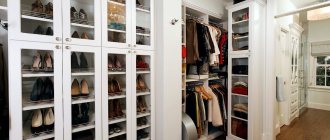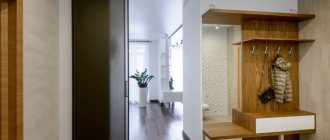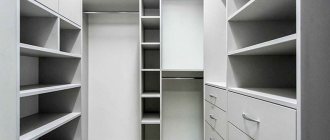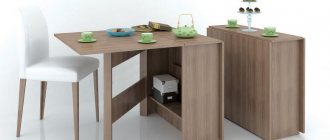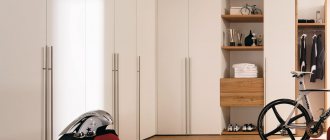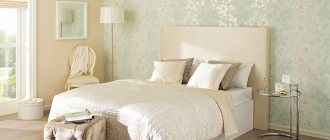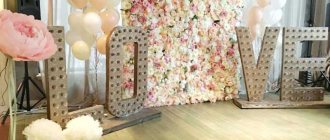Closet storage
A full-fledged design with hinged doors or a wardrobe with many compartments is quite spacious furniture, which is suitable not only for storing seasonal shoes, but also for a complete family wardrobe.
The photo shows an option for storing shoes in a closet with transparent glass fronts.
Roll-out cabinets in the form of a narrow or low design will fit perfectly into a small hallway. Small models allow you to store shoes compactly and do not take up much space.
Special shoe cabinet
This closet is a closed storage with special shelves: the shoes in them stand vertically, so even if you put dirty shoes there, all the dirt will flow into the groove, which you then simply need to rinse.
When purchasing a cabinet, pay attention to the height of the shelves. Some overshoes can only accommodate sneakers/shoes/boots, but full-height high boots will not fit. Most likely, it will be more rational to store them separately than to waste useful cabinet space under a double-height shelf.
Shoe shelves
Shoe shelves are an almost necessary element for the interior of any apartment or house, since this device provides a very neat organization of shoe storage.
There are a huge variety of different single-tier, multi-tier, floor-standing and hanging models. The main advantage of open horizontal or vertical structures is their large capacity.
The photo shows the interior of a dressing room with open shelves and shelves for storing shoes.
Retractable or folding shelves look very elegant in the interior. Such closed systems meet all storage conditions. They perfectly protect shoes from dirt, dust and sunlight.
All kinds of organizers
Basically, organizers are convenient fabric products that fasten with a zipper. This functional element has reinforced cardboard walls to maintain its shape and a transparent top that allows you to see the internal contents. Thanks to this, you won’t have to waste time searching for the right shoes or boots.
There are floor-mounted and wall-mounted models. A hanging door organizer is perfect for small spaces. Such a compact product with roomy pockets can easily be placed on the door leaf in the hallway or in the dressing room. However, please note that you cannot put dirty shoes in organizers.
The photo shows a compact fabric organizer for storing shoes.
Boxes and boxes
For organized storage by season or sorting shoes for each family member, use transparent boxes, which not only provide a quick search for the right pair, but also make the room functional and very stylish. Such products can be located in a closet or on open shelves.
No less original and convenient are plastic boxes made of polypropylene, which does not emit unpleasant odors. These systems are sufficiently thick and do not deform under the weight of footwear. Most boxes are equipped with special openings for high-quality ventilation.
The photo shows a method for storing shoes in a cardboard box.
An unusual solution for storing shoes would be wooden boxes that can be painted, varnished and fixed in the desired order on the wall. Wicker models made of rattan or wicker are distinguished by easy cleaning and high moisture-resistant qualities.
Boxes and crates are quite compact and mobile. Therefore, they can be laid out even on mezzanines.
How to properly care for and store shoes
Proper storage and care will extend the life of your shoes. Maintaining optimal temperature and humidity at its location will preserve its appearance without losing the quality characteristics of the material. Many of its species are very capricious. Therefore, it is necessary to protect your favorite shoes and boots as much as possible from contact with moisture, dust, and dirt. Care measures should include cleaning, washing, drying. For certain types of material, polishing and impregnation are used.
Leather
Before hiding leather shoes in a box, you need to carry out standard procedures: wash the soles, remove dirt and dust from the upper part and dry. If these are winter boots, the insoles must be removed and washed separately. Fasteners and locks must be unfastened and left open. Dried shoes should be soaked in protective cream several times and left on an open shelf until completely absorbed.
To keep boots or shoes in shape, crumpled paper or special foam products are placed in socks. If these are fur boots, they must be treated with a remedy against moths and other pests. It is better to store leather and leatherette in its natural position, without bending or twisting the tops. Low shoes are placed on the soles, and high ones are laid horizontally or hung in a case.
Leather shoes can only be dried outdoors. Do not place boots near open fires or heating devices.
Suede and nubuck
For regular care and preparation for storage, only products specifically designed for the material should be used for suede and nubuck. To clean fleecy shoes, use rubber brushes or a simple office grater. Suede products are not afraid of moisture, so they can be easily washed with warm water. Nubuck can only be cleaned with a dry brush.
Suede and nubuck shoes should be stored at average room temperature. Cured leather does not tolerate heat or cold. You cannot leave products on the balcony or in the garage in winter. Breathable materials must be used for packaging. Cardboard or a textile bag will do. Each boot must be wrapped separately.
Rubber Shoes
In order for rubber boots to perform their functions for as long as possible and maintain their integrity, it is necessary to provide them with high-quality care. It is necessary to wipe off moisture from both the outer and inner surfaces. You can remove dirt or scratches from white items using an eraser or a piece of rubber.
Before storing boots for long-term storage, the entire surface should be treated with glycerin or special oil for rubber products. If they have been worn for a long time, the inside must be disinfected. To treat and eliminate unpleasant odors, use a weak solution of potassium permanganate or hydrogen peroxide.
The storage space for rubber shoes should be spacious and not require squeezing or bending. The optimal temperature is 5-15 °C. Models with high tops are stored in an upright position.
Patent leather shoes
Only special care products are suitable for such products. Impregnations for varnish are water-based, which provides soft, gentle moisture. You can even disguise scratches and abrasions with a simple nail polish of a suitable color. To soften the material and prevent cracking, it is recommended to use Vaseline after each contact with water.
Since patent leather shoes are not intended for daily wear, it is very important to ensure proper storage. To maintain the shape of a varnished pair, special holders are used - blocks made of wood, plastic, or foam. They are placed inside and twisted, stretching the boots in width and length. Patent leather shoes must be stored in separate bags. Shiny surfaces should not touch, otherwise they may become dull or scratched.
Shoe racks
Oversized storage system equipped with horizontal shelves. Shelving structures are mainly installed in a spacious hallway, in a separate storage room, dressing room or in a niche.
Open shelving allows you to neatly store shoes neatly arranged in a row. Such models are well suited for children's shoes, as everything is at hand and provides an excellent overview.
The photo shows tall shoe racks in the interior of a dressing room.
Types of furniture for storing shoes
Storing shoes is a perennial problem. Hallways are usually not as spacious as we would like, so everything needs to be placed compactly, but so that access is free. Shoe racks of different types and types help to cope with the task. If we try to give a definition, we can say that a shoe rack is an open or closed shelf for shoes. Closed ones are called shoe chests or cabinets, open ones are called “shelves” or “stands.” If the design is not specified, the general concept of “shoe rack” is used.
The shoe rack for the hallway can be open or closed
A closed shoe storage system can be made in different ways. All models can be divided into several groups:
- With folding shelves. A shoe rack in a hallway with folding shelves usually has a shallow depth; they vary in height and width - low and wide, narrow and high. Their distinctive feature is a shelf attached to the door, and this structure is fixed on rotary hinges. When you pull the handle on the door, it rotates on its hinges, allowing access to the contents of the drawer. This is how a folding shoe chest works
- With hinged doors. This is an ordinary shoe cabinet, of a wide variety of sizes, for different numbers of shoes. Hinged doors are familiar, but not very convenient
- With sliding doors. These models are good if the hallway is very narrow and open doors will get in the way.
Such furniture for storing shoes is called a chest of drawers or (cabinet) for shoes. There is no clear division. Everyone uses the name they like best.
Closed models
Closed models of shoe racks are called a shoe cabinet or chest of drawers. They vary in size. Height - from 50 cm to 220 cm, width - from 30 to 120 cm, depth - from 17 to 55 cm. Next, we will consider how tall a shoe rack in the hallway can be. It is this factor that is considered first.
Wardrobes or chests of drawers for shoes - this is the name of closed-type shoe boots
Low boots
Low overshoes are made up to 50-55 cm high. They usually have only one shelf, on which one person’s seasonal shoes can be placed. And only if he is not very keen on buying new shoes/sandals/boots. Occasionally, two low shelves are made in a low shoe rack. Only summer or autumn shoes without heels can be placed normally. Boots and even boots will no longer fit on such shelves. Unless you put them sideways.
Low shelves for shoes are often equipped with a seat
With attached drawer for small items
The advantage of a low chest of drawers for shoes can be the seat. That is, in your hallway there is not just a bench/banquette for putting on shoes, but furniture for shoes with a seat. Rational use of all available space is what this option also provides.
Medium height
With a height of 60 to 120 cm, the shelves are already enough to accommodate the shoes of a family of 3-4 people. In this segment there are chests of drawers for shoes with open shelves, which are placed on the sides of the shoe shelves. Most often there is a long and narrow section for storing an umbrella. Ladies can adapt this section to high boots.
The average height is optimal: everything is at hand
There are different styles, you can choose them to suit any interior.
Several options: with and without shelves for small items
There are not only tall and narrow
There are models of chests of drawers for shoes in the upper part of which there is a shelf for small items; there are also drawers for storing gloves, keys, etc. To make efficient use of space, you can hang a mirror or a wall hanger above the shoe cabinet.
Tall shoe cabinets
Perhaps the most interesting category. It makes sense to take these shoe racks in the hallway at the same height as the closet (if you have one in your hallway). Even though not all shelves can be easily reached, you can put off-season or weekend shoes on the top ones. In addition to traditional shoe cabinets with hinged doors, there is a narrow shoe cabinet with pull-out shelves. This option is good if you have a small distance - 30-40 cm - between, say, a closet and a wall. It is in such niches that you can put such narrow and deep shoe cabinets. They are also called “shoe cases”.
A cabinet for shoes of small width is called a “pencil case”
A closed shoe rack in the hallway is good because the doors reliably hide order or disorder. The second positive point is aesthetic. Many people like these models better than open shelves. Closed models also have disadvantages. The first is that shoes dry in them longer, the second is that their price is higher, since more material is required.
Shoe racks in an open hallway
The design of a shoe rack in an open corridor is simple: two sidewalls to which shelves are attached. In height, they are usually either low - up to 50 cm high, or medium in height - up to a meter. High ones are extremely rare. There are also several typical models in this category:
- A regular shoe rack. Height - up to 80 cm, width - from 50 cm, depth - from 35 cm, otherwise large men's shoes will not fit in it. A simple shoe stand has from two to five shelves, depending on the height. Some models have closed shelves on the sides. They can be used for storing shoes and other things.
Shoe racks are one of the most practical options. The downside is that dust settles on the shoes... well, and the fact that you have to maintain order
Homemade wooden shoe rack
Metal models are not too expensive, but practical and durable
Combination of wood and metal
Shoe rack with seat. The height of this furniture for storing shoes is small - around 50-60 cm. Otherwise, it is uncomfortable to sit. Their width starts from 60 cm, depth - from 40 cm. When purchasing such a model, pay attention to the strength of the frame: it can withstand the weight of a sitting person.
If the shoe rack is divided into cells, make sure that they are rectangular - square ones are inconvenient...
The cheapest - plastic shoe shelves
Shoe shelves made of chipboard and metal of medium height
They can be made of wood, MDF, metal and a combination of these materials. If we talk about the choice of material, then it makes sense to match the furniture that is already in your hallway. If you cannot find the same material or color, look for a similar one. Simple metal models look neutral. This shoe rack will fit into the hallway of any style.
Shoe shelves made of wood, chipboard or MDF look more interesting. Even a simple wooden shelf can look good. It benefits from the texture of the wood. It doesn't have to be hidden behind a door.
Shoe rack in the hallway made of wood: even a simple model benefits from the beauty of wood
There are also open shoe racks, which are called racks or shoe stands. They don't have shelves; the blades on which the shoes are placed are made of wire or plastic. A very convenient and compact way to store summer and autumn shoes. These shoes can fit up to 36 pairs in a small space. There is a special model for “installing” boots. The number of pairs is smaller, but the problem with creases in the tops has been solved. A worthy solution.
Unusual hanger
They look good and are made from chipboard and MDF. They are usually laminated with wood-like films, which gives them solidity. Next to the open shelf there may be a couple of closed ones. This option is not bad: you can store in open ones those pairs that you are currently wearing, in closed ones you can rarely put on shoes or until the time has come for them.
Suspension systems
It would be appropriate to put small soft shoes in the hanging pockets. These models have a flat design, which allows you to significantly save space. Pockets are sometimes decorated in an original way and turn them into an unusual decoration of the entire interior.
The photo shows storing shoes in fabric hanging items inside the wardrobe.
Hidden storage systems
Hidden storage space makes the surrounding space much more aesthetically pleasing, keeps the room tidy and solves the problem of saving usable space.
In the interior of the home, numerous shoe items can be stored in cabinets under the stairwell or in hidden pull-out shelves in the steps. This solution is suitable not only for storing shoes, but also for seasonal items or other necessary little things.
The photo shows a roll-out tray for storing shoes under the bed.
It would also be appropriate to use the space under the bed. Shoes can be stored in special wooden pallets, transparent containers or organizers.
Why hide out-of-season shoes?
Storage was invented not only to provide people with an easy but regular job of sorting things, it also solves other problems, including saving money.
Yes, yes, properly organized storage increases the service life of shoes, which means you will have to buy them less often. Other advantages include facilitating searches and optimizing space.
Of course, there is a temptation not to hide anything or put anything away. True, then you shouldn’t be surprised when after a couple of months you discover that your favorite shoes have lost their presentable appearance or have begun to rub with calluses.
Ottomans
A compact and neat pouf with a special folding seat not only allows you to store summer shoes or winter boots, but also provides the most comfortable process for changing shoes. In addition, the ottoman, due to its specific stylistic design and upholstery made of different materials, becomes a bright accent of the entire interior.
Multifunctional bench chests or structures in the form of sofas and banquettes fit perfectly into the design of any corridor. Many designs are equipped with containers or textile covers with cells.
The photo shows an ottoman equipped with textile cells for storing shoes and boots.
Storage requirements
Any shoes are afraid of direct sunlight. The sun can not only dry out the material of the top, but also lead to a change in its color. Therefore, you should opt for a darkened space.
Moisture is also not shoes' best friend. When there is high humidity, mold forms on the shoes. Consequently, two more requirements are imposed on the storage location: it must be dry and ventilated.
Important: it is advisable to choose a place away from heating devices.
Baskets and buckets
For a hallway or dressing room in Provence or classic style, shoes can be stored in eco-friendly wicker baskets. Similar products, distinguished by high decorative properties, are placed under a bench or placed on shelves.
The photo shows wicker shoe baskets located under the bench in the hallway interior.
An interesting idea for storing shoes would be to use bright buckets. In these containers, intended for completely different purposes, you can store compact shoes.
Hangers, clothespins, hooks
In order to store high-top boots, hangers with two clothespins are used, which can be hung on a bar in the closet. Thanks to this life hack, creases will not appear on the shoes and they will retain their original appearance for a long time.
The photo shows the design of a wall in the hallway equipped with hooks for shoes.
Children's and men's lace-up shoes or high-heeled shoes can be stored on hooks on the wall. Shoes hung with laces tied with a bow will look original.
The photo shows special hangers for storing boots.
Shoe racks
Manufacturers have long been racking their brains over the optimal way to store furniture and have achieved some success. Just look at the variety of shoe racks that allow you to place your shoes compactly and attractively. You can make analogues of such racks yourself: for example, it is convenient to store boots on hangers with clips.
Cornices
You can use a curtain rod with curtain rings to store bright shoes and boots in an unusual way. Thanks to this creative approach, the interior acquires an individual look.
Shoes hung on mounts on the ledge are always within easy reach and allow you to free up useful space in the dressing room or hallway.
Original homemade devices
An old stepladder or ladder will serve as a shoe rack. The structure is decorated and fixed to make it more stable. Shoes and boots can be stored on the steps, and the rungs can be supplemented with hooks for hats and other accessories.
The remains of PVC water pipes represent a budget-friendly, but at the same time original shoe storage. The independent process of creating such a system does not take much time.
For indoor slippers or ballet shoes, it is appropriate to mount several aluminum jars on the wall. Such products have a neat, stylish and less bulky appearance, unlike plastic pipes. This design will fit perfectly into a small corridor in an industrial loft style.
The photo shows the idea of storing shoes in plastic pipes.
A simple metal lattice on which you can store shoes by hanging them by the heel will look impressive in the interior. In order to construct a shelf, scraps of pipes or an old battery are suitable.
Designs in the form of a shoe rack made from ordinary boxes, wire baskets, wooden packing boxes or a compact cardboard rack will help you organize storage correctly.
Sneakers and sneakers can be stored on shelves made of skateboards, and a memorable pair of shoes, such as a wedding, can be covered with an elegant glass cover and made the central decoration of the dressing room.
Non-standard storage locations
Sometimes, in order to find a suitable place, you need to carefully and critically examine the home. Is there a basket for papers or laundry in the house? Beautiful covers will turn these items into ottomans, inside which several pairs of light shoes will fit.
You can use wicker boxes for storage space, and they will also decorate the interior. A variety of drawers, suitcases, plastic boxes, roof rails - all this is an alternative to special cabinets - shoe racks.
Selection of storage accessories
As a useful accessory, a stand for shoes and boots is used, which is designed for two pairs at once. This method of storing shoes allows you to save useful space inside the closet or on the shelves.
The photo shows a plastic stand for storing two pairs of shoes.
In order to store shoes without boxes, you can purchase or sew bags made of thick but breathable fabric yourself.
Instead of using bulky boxes and containers, a pair of shoes is simply held together with an elastic band and packaged in airtight organizers that can be hidden under the bed or placed on the loggia.
The photo shows storing shoes in multi-colored sealed bags.
Any closet is like a shoe closet
Shoe storage can be made original by using a vintage cupboard or glass rack for this purpose. It’s good if it has a closed lower part and open shelves on top - then the prettiest shoes can be displayed on the shelves, let them serve as decoration, and felt boots or old sneakers can be hidden behind opaque doors.
